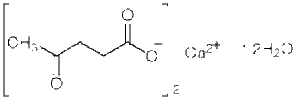| Anmol Chemicals is the pioneer manufacturers of Calcium Levulinate, Pharmaceutical Excipients Food & Flavor chemicals in India. We offer Halal and Kosher Calcium Levulinate made in an ISO9001, ISO22000 (FSSC22000) cGMP and GLP certified facility. Our group has several manufacturing facilities spread across the world, supported by toll manufacturers and representatives in UAE, Europe, Africa, USA, China and has several associated manufacturing facilities spread across India. All the Information on Physics, Chemistry, Applications, Uses and Technology on Manufacture of Calcium Levulinate is in these pages. |
| The units have one or more of the certifications like FDA GMP, ISO 9001, ISO 22000, HACCP, REACH, Kosher & Halal |





Calcium Levulinate BP Manufacturers
Calcium Levulinate SDS GHS, MSDS Sheet
Calcium Levulinate Dihydrate BP Grade
Ph Eur
C10H14CaO6,2H2O -- 306.3 -- CAS Number 5743-49-7
Action and use: Source of calcium.
DEFINITION
Calcium di(4-oxopentanoate) dihydrate.
Content: 98.0 per cent to 101.0 per cent (dried substance).
CHARACTERS
Appearance: White or almost white, crystalline powder.
Solubility: Freely soluble in water, very slightly soluble in ethanol (96 per cent), practically insoluble in methylene chloride.
IDENTIFICATION
First identificationı A, D, E.
Second identificationı B, C, D, E.
A. Infrared absorption spectrophotometry comparisonı calcium levulinate dihydrate CRS.
B. Thin-layer chromatography.
Test solution: Dissolve 60 mg of the substance to be examined in water and dilute to 1 ml with the same solvent.
Reference solution: Dissolve 60 mg of calcium levulinate dihydrate CRS in water and dilute to 1 ml with the same solvent.
Plate: TLC silica gel plate.
Mobile phase: concentrated ammonia, ethyl acetate, water, ethanol (96 per cent) (10:10:30:50 V/V/V/V).
Application: 10 μl.
Development: Over a path of 10 cm.
Drying: At 100-105 °C for 20 min and allow to cool.
Detection: Spray with a 30 g/l solution of potassium permanganate. Dry in a current of warm air for about 5 min or until the spots become yellow. Examine in daylight.
Results: The principal spot in the chromatogram obtained with the test solution is similar in position, colour and size to the principal spot in the chromatogram obtained with the reference solution.
C. To 1 ml of solution S (see Tests), add 20 ml of a 2.5 g/l solution of dinitrophenylhydrazine in dilute hydrochloric acid. Allow to stand for 15 min. Filter, wash the precipitate with water. Dry the precipitate in an oven at 100-105 °C. The melting point is 203 °C to 210 °C.
D. It gives reaction of calcium.
E. Loss on drying (see Tests).
TESTS
Solution S: Dissolve 10.0 g in carbon dioxide-free water R prepared from distilled water and dilute to 100.0 ml with the same solvent.
Appearance of solution: Solution S is clear and not more intensely coloured than reference solution.
pH: 6.8 to 7.8 for solution S.
Oxidisable substances: To 1 ml of solution S, add 10 ml of water, 1 ml of dilute sulphuric acid and 0.25 ml of a 3.0 g/l solution of potassium permanganate. Mix. After 5 min, the violet colour of the mixture is still visible.
Sucrose and reducing sugars: To 5 ml of solution S add 2 ml of hydrochloric acid and dilute to 10 ml with water. Heat to boiling for 5 min and allow to cool. Add 10 ml of sodium carbonate solution. Allow to stand for 5 min, dilute to 25 ml with water and filter. To 5 ml of the filtrate add 2 ml of cupri-tartaric solution and heat to boiling for 1 min. No red precipitate is formed.
Chlorides: Maximum 50 ppm.
Sulphates: Maximum 200 ppm.
Magnesium and alkali metals: Maximum 1.0 per cent.
To 10 ml of solution S, add 80 ml of water, 10 ml of ammonium chloride solution R and 1 ml of ammonia. Heat to boiling. To the boiling solution, add drop-wise 50 ml of warm ammonium oxalate solution. Allow to stand for 4 h, then dilute to 200 ml with water and filter. To 100 ml of the filtrate, add 0.5 ml of sulphuric acid. Evaporate to dryness on a water-bath and ignite to constant mass at 600 ± 50 °C. The residue weighs a maximum of 5.0 mg.
Heavy metals: Maximum 10 ppm.
Loss on drying: 11.0 per cent to 12.5 per cent, determined on 0.200 g by drying at 105 °C.
Pyrogens: If intended for use in the manufacture of parenteral dosage forms without a further appropriate procedure for the removal of pyrogens, it complies with the test for pyrogens. Inject per kilogram of the rabbit's mass 4 ml of a solution containing per millilitre 50 mg of the substance to be examined.
ASSAY
Dissolve 0.240 g in 50 ml of water R . Carry out the complexometric titration of calcium. 1 ml of 0.1 M sodium edetate is equivalent to 27.03 mg of C10H14CaO6.
For Original Monographs of IP Indian Pharmacopoeia BP British Pharmacopoeia USP US Pharmacopoeia FCC Food Grade product, please check with the respective web-pages or books.
Manufacturers
Anmol Chemicals
S-8, SARIFA MANSION, 2ND FLANK ROAD, CHINCHBUNDER, MUMBAI 400009, INDIA
TEL: (OFFICE) 91-22-23770100, 23726950, 23774610, 23723564. FAX: 91-22-23728264
e-mail: anmolc@mtnl.net.in

Exports to USA, Canada, UAE, Dubai, South Africa, Tanzania, Kenya, Nigeria, Egypt, Uganda, Turkey, Mexico, Brazil, Chile, Argentina, Europe Netherlands, Italy, Spain, Germany, Portugal, France, Malaysia, Indonesia, Thailand, Norway, Ukraine, Korea, Japan, etc.
Copyright and Usual Disclaimer is Applicable. 20 January, 2022